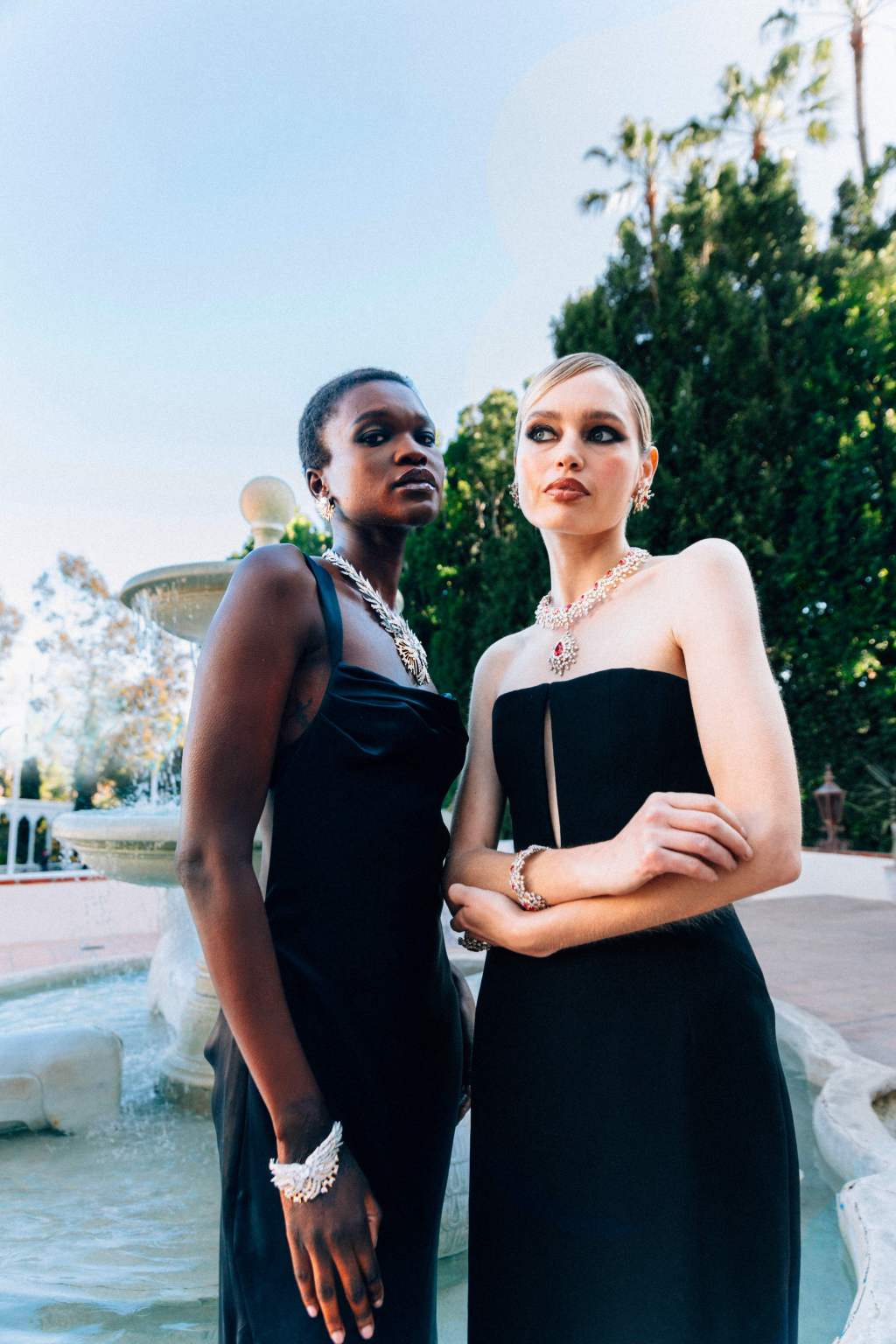LOS ANGELES — Tiffany & Co. is turning to the heavens — and the stars — for the debut of its 2024 Blue Book collection in Los Angeles.
On Thursday night, Anya Taylor-Joy, Emily Blunt, Gal Gadot and 150 other friends of the LVMH Moët Hennessy Louis Vuitton-owned maison will attend the launch at the historic Beverly Estate. They will follow in the footsteps of William Randolph Hearst and Marion Davies, who lived in the home in the 1940s; Beyoncé, who filmed part of “Black Is King” here, and many others who have used the sprawling landmark as a set over the years.
WWD got an exclusive preview of the Céleste collection from Nathalie Verdeille, Tiffany & Co. chief artistic director of jewelry and high jewelry, a category that Tiffany chief executive officer Anthony Ledru said defies the luxury slowdown and is “recession proof.”
First published in 1845, the Tiffany & Co. Blue Book was the first direct-mail catalogue to bring fine jewelry to American households. In the decades that followed, its pages became the stuff of luxury legend, showcasing the most extravagant stones and creations.
“It started with the Gold Rush on the West Coast actually, that’s when [Charles Lewis Tiffany] realized there was a lot of wealth here,” said Ledru of the early marketing effort, which has evolved into the Blue Book Collection, the maison’s version of haute couture.
Céleste is the largest Blue Book collection to date by the numbers and retail value. There are 157 pieces with an average price point of “close to a million if not above,” Ledru said. The range is inspired by legendary Tiffany jeweler Jean Schlumberger, who joined the company in 1956 and ushered in a golden era with his fantastical nature-inspired designs.
“We worked on Out of the Blue last year, going to the depths of the sea. Céleste was going in the opposite direction, to the sun, cosmos, rays of light, a fantasy world of mystical symbols,” Verdeille said during a tour of four rooms of jewels, going from the most expensive couture pieces to reimagined Schlumberger classics in Sleeping Beauty turquoise, pearls and precious stones, to more entry-level pieces (if you can say that in this milieu) with star, fringe, enamel, bird and fish motifs, and the first Tiffany & Co. handbags incorporating aspects of the fine jewelry.
The crown jewel of the collection is a heart-stopping winged diamond Pegasus necklace inspired by the symbol of flight, in platinum and 18-karat yellow gold with a diamond of more than 20 carats.

“It’s a way to work with different pixelization of diamonds, all kinds of cuts…and we developed a new feather setting, a new way to work the metal,” Verdeille said, highlighting how the technique adds a brightness to the gold and platinum.
Other pieces take cues from constellations with Colombian emeralds and diamonds in arrow shapes, and bring the decorative art of marquetry to star-like settings. “Normally, you see it in stone or mother of pearl, but here it’s a mix of sapphires, diamonds, mother-of-pearl and white gold,” Verdeille said.
A sparkler of a ring, gobsmacking even by Beverly Hills standards, features a 25-carat pink sapphire set between twinkling diamond stars.
The Apollo collar, after Schlumberger’s original Apollo brooch design from 1957, is constructed of gold links encasing white diamonds around a 10-carat yellow diamond mimicking electrons “dancing around the atom,” Verdeille said.

The Ray of Light group evokes sunbeams in platinum and 18-karat yellow gold, with a necklace featuring 54 carats of red spinels that can be transformed into a modern-looking tiara.
A 25-carat blue zircon and pebble-like aquamarines “like the nebulous sky” light up a bracelet from the Iconic Star group. “It’s totally flexible and supple,” she said, demonstrating the ease of movement on the chunky cuff.
“Sometimes, Schlumberger was strict with the design, super precise, so we need to adapt the softness of the pieces,” she said of contouring them to be modern and wearable.

She also breaks from the past by creating pieces that can go together in suites, which Schlumberger never did. “I love also to design for men, so he can have the brooch and the women can wear the necklace. It’s a new way to think,” she said of the his-and-hers matching moment.
There’s a charming vitrine of Bird on a Rock brooches, after the 1965 Schlumberger design, featuring emeralds, rubellites, sapphires and opals. “For me, it’s more important to start with the stone and design around it,” Verdeille explained of her process.

Bird on a Rock brooches, featuring feathered friends perched atop significant precious stones, have been a commercial hit for Tiffany in recent months. And the jeweler is expanding on the flock; the design has hatched new jewelry iterations and a new group of watches on display in another room of the estate, including one with a complication designed to move with the wearer and be wound by gravity.
Schlumberger is a north star for the rebirth of the American luxury brand. Shortly after LVMH acquired it in January 2021, leadership began to place more emphasis on his archival designs originally conceived in the midcentury, when they found favor with Babe Paley, Jayne Wrightsman and Audrey Hepburn among other tastemakers.
“My favorite story is about the flower pot,” said Verdeille of her love of Schlumberger, referencing a piece he created in 1960 for Bunny Mellon, honoring her green thumb. “He found a famous stone and thought it was too vulgar to put in a necklace, so he asked the client to send him a ceramic pot — she enjoyed gardening — and designed a grill around it in gold, and a flower with the stone at the center. You can remove the flower and wear it as a brooch. For me, it’s all the craziness and magic of Schlumberger. He has no limits.”
Schlumberger is influencing design at all levels, she said, pointing to a new Tennis line using the designer’s ribbon and thread motifs, harkening back to his family’s history in the textile industry. Bags, too, capture the spirit, with intertwining ribbon forming the basis for hardware (precious and non-precious options available) on jewel-toned leather box silhouettes.
Verdeille joined Tiffany in 2021, after serving as creative director for jewelry at Cartier since 2005.
She previously led high jewelry design at Chaumet, which is part of LVMH’s watches and jewelry business division.
“For me the DNA of the brand is incredible. But what I knew of it being French was not the same as understanding it as someone growing up in the U.S.,” she said of discovering how Tiffany historically has been part of Americans’ milestone moments, from silver baby rattles to wedding rings.
“We create each category for a part of your life,” she said. “The first time I came to New York at 18, Tiffany was the first store I visited. It was an institution and it was not open yet in Paris. When you step in the boutique, something happens. The magic of the brand is incredible and I discover new ways to think about it every day,” Verdeille said.
“It’s super American — in a good way. The wedding rings for example, we don’t set the diamonds in the same way in Europe. They’re cut to [maximize] the light and brightness,” she said. “I love to marry the European technique and the American technique. We’re twisting things in a different way. And it’s appropriate to Schlumberger because it’s not static design…it’s made to accentuate possibility and movement.”


